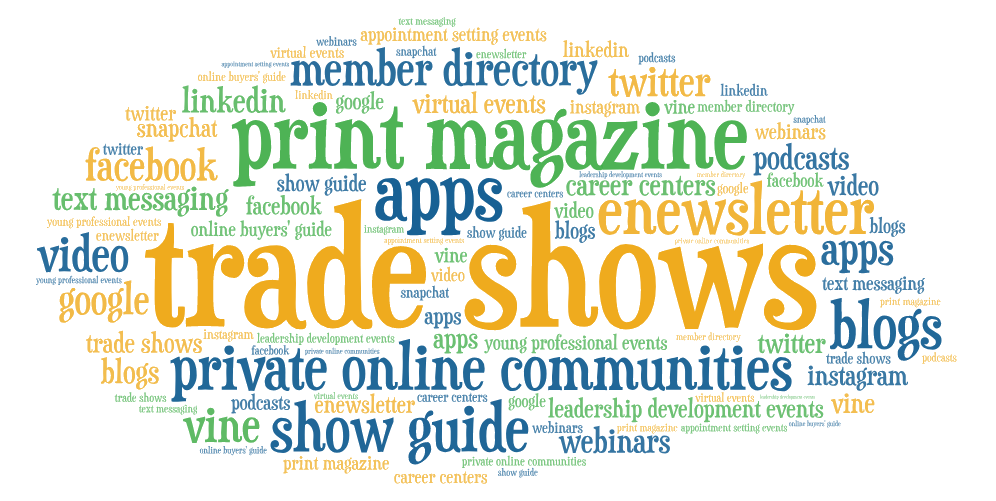Balancing Traditional and Trending Member Communications
Finding balance can be a tricky endeavor. Too much (or too little) of any given thing on one side tips the scales and creates an uneven approach.
This year’s Association Communications Benchmarking Study showed us that traditional forms of member communication – live events and print media – continue to be popular among associations and their members. Live events remain the No. 1 most-valued member communication channel, according to our survey respondents, again taking the top spot and proving that face-to-face content and networking is important no matter what your industry is or who your members are.
At the same time, print media is seeing a resurgence. The print magazine was the second most highly valued communication channel this year. Joining the top 10 were the print newsletter and print conference guide. This shouldn’t come as a surprise: Our inboxes are overrun with emails and our smartphones rarely leave our sight, but our mailboxes are virtually empty. When something arrives on our desk nowadays, it is novel and stands out.
While these more traditional forms of communication continue to thrive, trending platforms used in mainstream life – apps, texting and private online communities – also saw huge growth in popularity. Podcasts, which are a great way to share content and tell your association’s story in a way that members can easily digest anywhere, at any time – grew by 27 percent. And don’t discount social media, which remains an important way to reach members. Look to apps like Instagram, where you can visually connect through images and graphics.
Now that we know both traditional and trending forms of communication for vital for members, the question becomes: How does your staff balance all these communication platforms and create a content strategy that doesn’t overwhelm members with messages coming from all directions?
-
Repurpose content whenever and wherever possible.
Adding a new member communication platform to your association’s repertoire will certainly lead to questions about time and resources for your staff. Launching a new product can be challenging because of the additional content it will require. So, work smarter, not harder. Repurposing relevant content across multiple communication platforms allows you to get the most life out of the content your association already has. Most associations have a wealth of content that is relegated to only one platform. Instead, your association should be taking a holistic view of your communications and sharing content across print, digital and social to get the most exposure.
Here’s a good example of repurposing content: You record the most popular session at your annual conference and use it later as a webinar. That session can also be the basis for a print magazine article, story on your blog and interview in your digital newsletter, all of which should be promoted on social media and used to start a discussion thread in your online community.
It’s likely that members will see that one piece of content in different ways, but utilizing multiple platforms and multiple formats ensures that you get in front of more members in a way that they find convenient in their day-to-day lives.
-
Don’t think of new member communication as all or nothing.
New communication platforms are introduced often, and it can feel impossible to keep up with the latest and greatest way of communicating with your members. The good news is you don’t have to jump on every new bandwagon – you just have to do what is right for your members.

In this year’s benchmarking survey, associations shared with us that they’re using 28 different member communications channels regularly. With that said, 51 percent of respondents reported feeling their association is understaffed, which makes sense when you’re trying to communicate with members using all of those platforms. It can be overwhelming for your staff as they attempt to create and produce so much content, but it is also likely overwhelming to your members on the receiving end. This proves what we’ve been saying for some time: that it’s essential to know with certainty your members’ communications needs and wants.
Don’t think that your association has to adopt every new platform available. Instead, survey your members and talk with them about how they want to communicate with you. If your membership uses social media, that’s great and it’s where your association should be. Find out what specific sites they use though and put a majority of your focus there. It’s okay to not go all in on a communication platform that only a few members use. It’s also okay to try a new platform on a test basis to see if it’s a fit. Create a pilot program for a set amount of time to see what response your get from your members. Successful programs can be added to your overall communication plan, and those that don’t meet a predetermined rate of effectiveness can be set aside to revisit in the future.
-
Find help along the way.
Understand that your association doesn’t have to go it alone. Whether it’s technology tools that can help or partners who can lighten the load, look for additional resources that can help your association find the right balance with all the options out there.
There are programs that can help associations manage multiple social media platforms, organize articles and stories for print and digital publications, and record and edit audio for podcasts or video. Each of these is inexpensive – or even free. Test out different programs – many often have tutorial videos that show you how they work – to see which best fits your needs before committing to a subscription.
Also be on the lookout for people or companies you can partner with to assist with certain aspects of your communications. Volunteers who have a background or interest in marketing and communications could take on specific roles within your overall program. Create an editorial committee that can assist your staff in crafting a content strategy that reflects members’ voices and opinions, and make sure your members are offered the opportunity to contribute content that showcases their industry expertise and thought leadership.
External member communication partners can also be a reliable resource for your association. Use their expertise to help guide you in the right direction for content strategy, technology support and even advertising sales. Look for companies that see themselves as an extension of your own association staff and take your unique challenges into consideration when planning your communications. No two associations are the same, nor should two associations’ communication strategies.
How does your association balance tradition and trends in member communications? Share your tips below.


